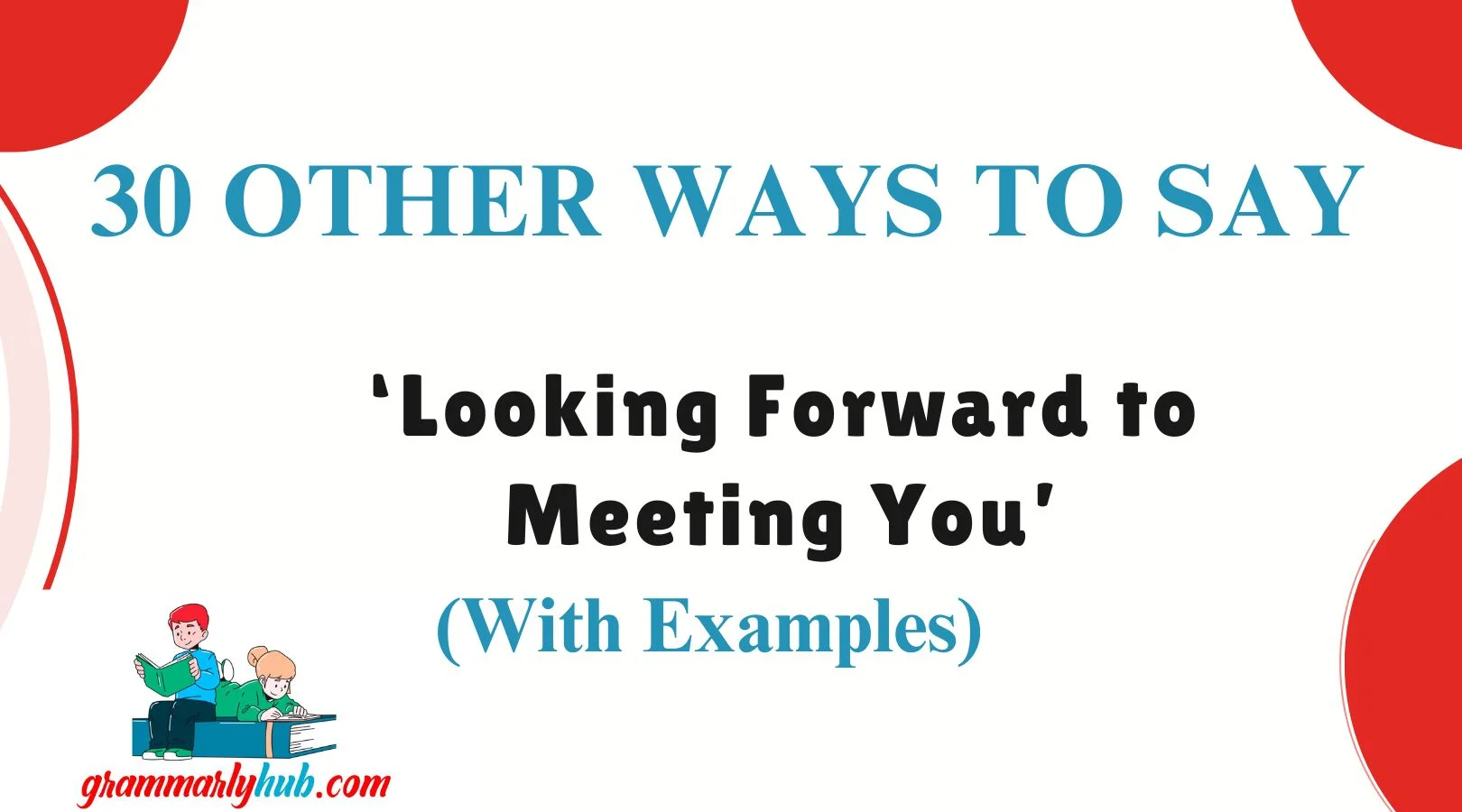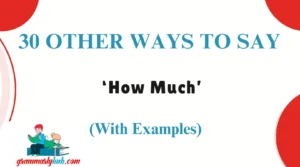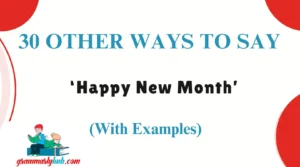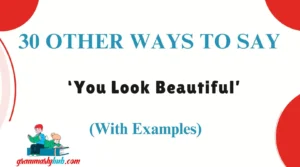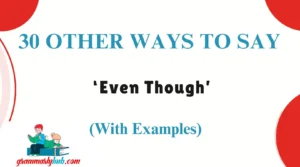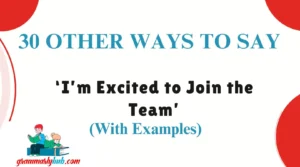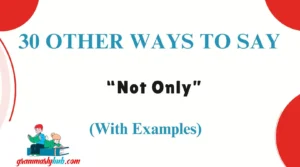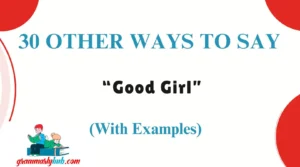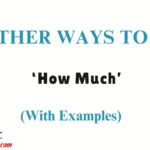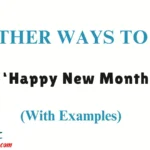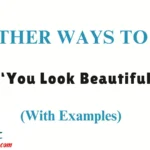Finding the right words to express excitement and warmth when anticipating a meeting can make all the difference in how your message is received. Saying “Looking forward to meeting you” is common, but sometimes you want to add a personal touch or sound a bit more thoughtful and engaging.
Whether it’s for professional emails, personal invitations, or friendly notes, using varied expressions can show genuine care and enthusiasm. In this article, you’ll discover 30 alternative ways to say this phrase, each with detailed explanations, examples, and tips on when and how to use them effectively. Let’s explore how to communicate your eagerness with warmth and sincerity.
What Does “Looking Forward to Meeting You” Mean?
Looking forward to meeting you means expressing anticipation and positive feelings about an upcoming encounter with someone. It conveys eagerness, respect, and a hopeful attitude toward building a connection. This phrase is often used in both professional and casual communication to show courtesy and enthusiasm for the scheduled meeting or introduction.
When to Use “Looking Forward to Meeting You”
This phrase works well in contexts where a meeting is planned but has not yet occurred. Use it to express polite excitement in emails, invitations, or messages before job interviews, business meetings, networking events, or social gatherings. It helps set a friendly tone and builds rapport before the actual interaction.
Is It Professional/Polite to Say “Looking Forward to Meeting You”?
Yes, “Looking forward to meeting you” is both professional and polite. It strikes a good balance of formality and warmth, making it suitable for business communication and more casual exchanges alike. However, depending on the context, varying the phrase can sometimes convey a more personalized or nuanced tone.
Pros and Cons of Saying “Looking Forward to Meeting You”
Pros:
- Clear and universally understood
- Polite and respectful
- Shows enthusiasm and positivity
Cons:
- Can sound generic if overused
- May lack personal warmth or creativity
- Might feel formal or stiff in casual settings
Synonyms for “Looking Forward to Meeting You”
- Can’t wait to meet you
- Excited to meet you
- Eager to connect with you
- Anticipating our meeting
- I’m thrilled to meet you
- Looking ahead to our meeting
- Counting down the days to meet you
- Can’t wait to get to know you
- It’ll be great to meet you
- I’m pleased to be meeting you
- Ready and eager to meet you
- I look forward to our time together
- Enthusiastic about meeting you
- Can’t wait to catch up with you
- Looking forward to seeing you in person
- Excited for our upcoming meeting
- I’m happy to be meeting you soon
- Anticipating a great meeting with you
- Looking forward to chatting face to face
- Eagerly awaiting our meeting
- It’s a pleasure to be meeting you
- Can’t wait for our paths to cross
- Looking forward to making your acquaintance
- Excited about our meeting ahead
- Ready to meet you soon
- I’m looking forward to spending time with you
- Anticipating our conversation
- I’m eager to collaborate with you
- Looking forward to joining you
- I’m delighted to meet you
1. Can’t Wait to Meet You
Definition: A casual and enthusiastic way to express eagerness for an upcoming meeting.
Explanation: This phrase is informal, showing genuine excitement.
Scenario Example: “Can’t wait to meet you at the conference next week!”
Worst Use: Avoid in very formal or professional communications.
Tone: Friendly, energetic, informal.
2. Excited to Meet You
Definition: Expresses positive anticipation with warmth.
Explanation: Slightly more formal than “can’t wait,” good for both casual and some professional contexts.
Scenario Example: “I’m excited to meet you and discuss the project details.”
Worst Use: May feel too casual for very high-level formal situations.
Tone: Warm, enthusiastic, moderately formal.
3. Eager to Connect with You
Definition: Shows interest in forming a connection, beyond just the meeting itself.
Explanation: Implies a desire to build rapport or network.
Scenario Example: “I’m eager to connect with you and learn more about your work.”
Worst Use: Avoid if the meeting is purely transactional without a relationship focus.
Tone: Professional, interested, engaged.
4. Anticipating Our Meeting
Definition: A polite, slightly formal way to express expectation.
Explanation: This phrase conveys thoughtful preparation and respect.
Scenario Example: “Anticipating our meeting on Thursday to discuss the partnership.”
Worst Use: Can sound too stiff in casual settings.
Tone: Formal, respectful, neutral.
5. I’m Thrilled to Meet You
Definition: Expresses strong excitement and happiness about the meeting.
Explanation: Best used when the meeting is something the speaker truly values.
Scenario Example: “I’m thrilled to meet you and hear your insights.”
Worst Use: May be overly emotional for strictly business contexts.
Tone: Enthusiastic, heartfelt, informal to semi-formal.
6. Looking Ahead to Our Meeting
Definition: Shows a forward-thinking and positive attitude.
Explanation: A professional phrase that gently expresses eagerness.
Scenario Example: “Looking ahead to our meeting to finalize the details.”
Worst Use: Avoid in highly casual conversations.
Tone: Professional, polite, optimistic.
7. Counting Down the Days to Meet You
Definition: A playful and excited way to show anticipation.
Explanation: More informal and personal, ideal for friendly or casual meetings.
Scenario Example: “Counting down the days to meet you at the reunion!”
Worst Use: Too informal for business or first-time meetings.
Tone: Casual, enthusiastic, friendly.
8. Can’t Wait to Get to Know You
Definition: Emphasizes interest in learning about the other person.
Explanation: Great for relationship-building contexts.
Scenario Example: “Can’t wait to get to know you better at our meeting.”
Worst Use: May not suit brief or transactional meetings.
Tone: Warm, personal, informal to semi-formal.
9. It’ll Be Great to Meet You
Definition: Expresses confidence that the meeting will be positive.
Explanation: Neutral and optimistic, good for many settings.
Scenario Example: “It’ll be great to meet you and discuss collaboration opportunities.”
Worst Use: Might sound bland if used repeatedly.
Tone: Friendly, neutral, professional.
10. I’m Pleased to Be Meeting You
Definition: Formal and polite expression of positive anticipation.
Explanation: Appropriate for first-time professional introductions.
Scenario Example: “I’m pleased to be meeting you during the upcoming conference.”
Worst Use: Avoid casual or informal chats.
Tone: Formal, respectful, courteous.
11. Ready and Eager to Meet You
Definition: Conveys both preparedness and genuine interest in the meeting.
Explanation: A confident way to show excitement while sounding organized.
Scenario Example: “I’m ready and eager to meet you to discuss how we can work together.”
Worst Use: Might come off as overly assertive in sensitive or high-pressure meetings.
Tone: Confident, professional, optimistic.
12. I Look Forward to Our Time Together
Definition: A gentle, thoughtful way to express anticipation.
Explanation: Suggests the meeting is valuable and time well-spent.
Scenario Example: “I look forward to our time together this Friday.”
Worst Use: May sound too soft or vague in a formal business setting.
Tone: Warm, gracious, personal.
13. Enthusiastic About Meeting You
Definition: Expresses strong interest and energy.
Explanation: Best when you want to show genuine excitement in a professional way.
Scenario Example: “I’m enthusiastic about meeting you and learning more about your vision.”
Worst Use: Could sound excessive if the relationship is still very new.
Tone: Energized, professional, upbeat.
14. Can’t Wait to Catch Up With You
Definition: Implies reconnecting with someone you’ve already met.
Explanation: Ideal for ongoing relationships or previous contacts.
Scenario Example: “Can’t wait to catch up with you next week at the expo!”
Worst Use: Not suitable for first-time introductions.
Tone: Friendly, casual, familiar.
15. Looking Forward to Seeing You in Person
Definition: Highlights the face-to-face aspect of the meeting.
Explanation: Great when transitioning from virtual or email communication to in-person.
Scenario Example: “Looking forward to seeing you in person after all our online chats.”
Worst Use: Unnecessary if the meeting is not physical.
Tone: Warm, professional, personal.
16. Excited for Our Upcoming Meeting
Definition: Shows general anticipation in a business-friendly way.
Explanation: Balanced tone, suitable for many settings.
Scenario Example: “I’m excited for our upcoming meeting to explore partnership options.”
Worst Use: May feel repetitive if used too often.
Tone: Positive, formal, enthusiastic.
17. I’m Happy to Be Meeting You Soon
Definition: A gentle, kind way to express pleasant expectation.
Explanation: Conveys personal warmth without being overly casual.
Scenario Example: “I’m happy to be meeting you soon to go over the project scope.”
Worst Use: Slightly vague for formal or detail-driven emails.
Tone: Gracious, light, friendly.
18. Anticipating a Great Meeting With You
Definition: Suggests hopefulness for a positive experience.
Explanation: Focuses on the quality of the interaction.
Scenario Example: “Anticipating a great meeting with you next Monday to finalize the deal.”
Worst Use: Avoid if you’re unsure the meeting will go well.
Tone: Hopeful, professional, respectful.
19. Looking Forward to Chatting Face to Face
Definition: A relaxed, friendly way to note the in-person nature of the conversation.
Explanation: Good when meeting someone you’ve already had conversations with.
Scenario Example: “Looking forward to chatting face to face after all those calls.”
Worst Use: Not appropriate for highly formal events or interviews.
Tone: Casual, warm, familiar.
20. Eagerly Awaiting Our Meeting
Definition: Emphasizes anticipation with a formal edge.
Explanation: Polished phrase that works well in business emails.
Scenario Example: “I’m eagerly awaiting our meeting to review the next steps.”
Worst Use: May feel stiff in informal settings.
Tone: Professional, refined, motivated.
21. It’s a Pleasure to Be Meeting You
Definition: Communicates honor and delight before the meeting occurs.
Explanation: Works well when meeting someone of importance or reputation.
Scenario Example: “It’s a pleasure to be meeting you after reading so much about your work.”
Worst Use: May sound overdone if the relationship is casual.
Tone: Respectful, polished, warm.
22. Can’t Wait for Our Paths to Cross
Definition: A creative, metaphorical way to express eagerness.
Explanation: Great for friendly, poetic, or social settings.
Scenario Example: “Can’t wait for our paths to cross next week at the retreat.”
Worst Use: Too poetic or vague for formal settings.
Tone: Creative, thoughtful, informal.
23. Looking Forward to Making Your Acquaintance
Definition: Very formal way of saying you’re excited to meet someone.
Explanation: Polite and respectful for first-time meetings.
Scenario Example: “I’m looking forward to making your acquaintance at the summit.”
Worst Use: Too old-fashioned or distant for casual use.
Tone: Formal, traditional, respectful.
24. Excited About Our Meeting Ahead
Definition: Emphasizes the future interaction with positive emotion.
Explanation: Works well in both business and personal settings.
Scenario Example: “Excited about our meeting ahead—lots to look forward to!”
Worst Use: Avoid if the meeting is meant to be serious or corrective.
Tone: Upbeat, flexible, forward-looking.
25. Ready to Meet You Soon
Definition: Indicates you are prepared and looking forward to the meeting.
Explanation: Useful when confirming or following up.
Scenario Example: “Just wanted to let you know I’m ready to meet you soon.”
Worst Use: Too abrupt without added context.
Tone: Direct, neutral, casual to semi-formal.
26. I’m Looking Forward to Spending Time With You
Definition: Expresses a more relational or emotional connection.
Explanation: Great for social events or personal interactions.
Scenario Example: “I’m looking forward to spending time with you over the weekend.”
Worst Use: Too personal for formal or corporate settings.
Tone: Warm, emotional, informal.
27. Anticipating Our Conversation
Definition: Focuses more on the verbal exchange than the physical meeting.
Explanation: Ideal when discussion is the primary goal.
Scenario Example: “Anticipating our conversation about your career goals.”
Worst Use: Not ideal if the meeting doesn’t involve real dialogue.
Tone: Professional, insightful, intentional.
28. I’m Eager to Collaborate With You
Definition: Emphasizes a shared purpose or task.
Explanation: Great for professional or team-based meetings.
Scenario Example: “I’m eager to collaborate with you on this upcoming project.”
Worst Use: Misleading if it’s not a collaborative session.
Tone: Motivated, respectful, professional.
29. Looking Forward to Joining You
Definition: Indicates you’re happy to participate in a meeting or event.
Explanation: Common in team settings or panels.
Scenario Example: “Looking forward to joining you in tomorrow’s strategy session.”
Worst Use: Vague if the meeting is one-on-one.
Tone: Team-oriented, positive, engaged.
30. I’m Delighted to Meet You
Definition: Expresses deep appreciation or honor.
Explanation: Best used in formal or respectful introductions.
Scenario Example: “I’m delighted to meet you and learn more about your role.”
Worst Use: May sound exaggerated in casual interactions.
Tone: Formal, respectful, courteous.
Conclusion
Expressing anticipation with the right phrase does more than just fill space in an email—it builds warmth, connection, and credibility. By choosing thoughtful alternatives to “Looking forward to meeting you,” you bring personality, empathy, and professionalism into your communication. Each of these 30 phrases offers a way to reflect your tone, intention, and relationship to the person you’re addressing.
Whether you’re writing to a potential employer, a colleague, or someone new in your personal life, these expressions will help you sound more human and connected—and in today’s world, that truly matters.
FAQs
1. Is it professional to say “Looking forward to meeting you”?
Yes, it’s considered both professional and polite. It’s a common phrase used in emails, interviews, and business communications. However, using a more personalized or specific alternative—like “Eager to connect with you to discuss our ideas”—can help your message stand out and feel more sincere.
2. What is a more formal way to say “Looking forward to meeting you”?
A more formal alternative could be “I look forward to making your acquaintance” or “I’m delighted to be meeting with you.” These options are respectful and polished, ideal for introductions, interviews, or meetings with senior professionals.
3. Can I use “Looking forward to meeting you” in a casual setting?
Absolutely. While it’s often used professionally, it can work in casual contexts too. For example, when meeting a friend’s family or attending a casual event, alternatives like “Can’t wait to see you” or “Excited to catch up soon” might feel warmer and more relaxed.
4. What’s the difference between “Looking forward to meeting you” and “Looking forward to seeing you”?
The difference lies in familiarity:
- “Meeting you” is best for first-time interactions.
- “Seeing you” is more common when reconnecting with someone you’ve already met.
Choosing the right one depends on your relationship and the setting.
5. Is “Looking forward to meeting you” appropriate in an email subject line?
Yes, it can be effective in a subject line, especially for scheduling or confirming a meeting. But consider alternatives like “Excited to Connect” or “Meeting Confirmation: [Your Name] & [Their Name]” to add clarity and stand out in a crowded inbox.

Emma Brooke is the voice behind Grammarly Hub, where grammar meets clarity. With a deep passion for the written word, Emma helps readers navigate the tricky waters of English grammar, writing tips, and effective communication.
